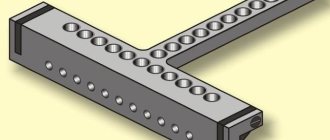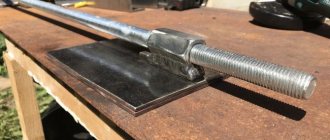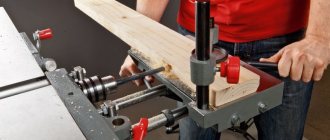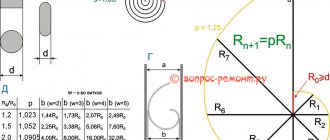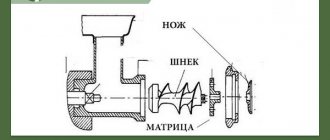First, let's figure out what a furniture jig is? Every time, assembling some kind of furniture, the master performs many completely identical marking operations (for example, marking 20 minifixes when assembling a cabinet means marking three completely identical holes with the same indentations). So, a jig is a device that allows you to optimize the processes of marking and/or drilling.
There are two main types of jigs : marking and drilling . If the former serve to simplify marking, then the latter allow you to completely remove this stage from the work, starting immediately with drilling holes. Looking ahead, I will say that it is better to have both types.
Naturally, good conductors cost money, so people get rid of them and come up with their own homemade versions, which are often no worse than factory ones.
Let's look at a few examples.
Marking furniture conductors:
Homemade conductor from a ruler. Probably the simplest and at the same time quite convenient and multi-purpose marking jig, which I recommend making. It is a ruler with a cross member screwed to it STRICTLY PERPENDICULAR. The ruler has holes drilled at certain distances from the beginning (for example, 32 mm for minifix, 100, 200, 300 mm for shelf holders, etc.)
Alternatively, you can use a ready-made carpenter’s square as a basis for such a jig (this is exactly what I have). It has its advantages (greater functionality) and disadvantages (less stable on the workpiece).
In addition, it uses highly specialized jigs, for example, for marking holes for furniture handles .
For marking furniture hinges, this is a factory jig, but who’s stopping you from making the same one?
In general, using several pieces of plastic, metal and even plywood, you can make a simple marking jig to suit your needs.
The professional marking conductor Assistent is a serious multi-purpose device. (I haven’t worked with it myself, but it seems to me that you can drill through it - it all depends on the bushings used).
Drilling jigs are more complex devices. The hole in them must not only be clearly opposite the desired location, but also be strictly perpendicular so that the drill does not go to the side during operation (for this, for example, replaceable bushings of different diameters are used or the thickness of the jig must be at least 10 mm).
The dubel-profi jig from KVB is an excellent household drilling jig (for amateurs), which comes with a bunch of accessories (rulers, clamps, etc.), is inexpensive and simplifies the work. I have two.
Professional drilling jigs. I think that the principle of operation is quite clear from the photo. Replaceable bushings – for drills of different diameters
Another option is a condor conductor. It has a system for positioning the jig on the workpiece and replaceable bushings.
Again, to suit your needs, you can make conductors of similar functionality with your own hands.
In short, the topic of conductors is almost endless))). To each his own and for his own. The main points, as I think, I have depicted - then it’s up to your pocket and/or ingenuity.
You can make maximum and precise holes in products based on natural wood, metal, MDF or chipboard using a special jig. This is an indispensable thing for those who produce furniture; such a device is also needed in other areas.
Such a conductor can be purchased ready-made, or you can make it yourself.
Features of application in the furniture industry
Conductors and templates are needed when assembling furniture. These things will prevent you from having a common problem that occurs during drilling—the drill hitting the part at the wrong angle. Correcting such an error will take an extremely long time, in some cases it will even be impossible.
A jig for making holes will not only allow you to correctly orient the working tool, but will also prevent it from straying from the desired trajectory.
In the furniture industry, jigs and templates are used in the following cases:
- in mass production;
- when assembling structures, when it is necessary to make holes for fasteners in the parts being connected. In this case, a jig for drilling holes for dowels or confirmat is suitable;
- a jig for drilling holes at an angle is used both in such cases and when working with thin boards, for example, MDF or chipboard.
When using such a device, the assembly process will be much easier and faster; you will be able to make the necessary holes regardless of how far they should be located from the edge of the part and how wide it is.
When assembling furniture yourself, you often have to connect parts end-to-end using dowels. Holes for dowels are best made using a special jig. The peculiarity of dowels is that despite the fact that such fasteners, although outdated, are still relevant in furniture production.
The difficulty in their use lies in the fact that the axes of the holes that are made in the parts when connecting must have a right angle with each other. Accordingly, they must be placed strictly perpendicular to each other. It is difficult to do this without a special device. Therefore, if you want to achieve high quality performance, it is recommended to buy a dowel jig.
Description
The most common type of fasteners for mounting elements of modular furniture made from sheets of chipboard, MDF and other wood-based materials are confirmed ones (euroscrews, euroscrews). These fasteners require preliminary drilling of 2 holes of different diameters: a blind hole at the end of one element being connected for the Euroscrew thread and a through hole in the face (plane) of the other element. It is almost impossible to do this with a regular drill, because the hole breaks, and it is rarely possible to create a right angle. In this regard, for such work it is necessary to have a toolkit called a conductor.
In fact, the jig is an ordinary template with holes of the required diameter.
For comfort, it can be equipped with a regulator and a locking device.
The jig guarantees the necessary direction of the cutting tool at right angles to the surface, preventing the possibility of moving to the side
This is especially important when working with narrow components of cabinet furniture, such as the end surfaces of doors or walls. Without this device, it is quite difficult to maintain the required angle, which can lead to a defect, since sometimes a slight deviation in the direction of the fastening hole can make it impossible to assemble individual parts into a solid structure
The devices are endowed with the following advantages:
- thanks to them, it is possible to obtain precise holes for additives for confirmats (Euroscrews);
- the toolkit does not require marking for a drill;
- any piece of furniture will be assembled much faster;
- you can make a specific number of holes without preliminary marking.
Other uses
Hole jigs are used not only in furniture production. Quite often they are used when you need to make a hole in a pipe or other cylindrical part. Thanks to them, you can make a high-quality hole even in a pipe with a small diameter.
Read also: What does a charger consist of?
Such devices are universal and easy to use, so they are also used in the following industries:
- mechanical engineering - drilling holes in different-sized workpieces based on different materials;
- construction - drilling holes in building structures;
- home communications - as already mentioned, pipe drilling and more.
Modern drilling jigs can be of different sizes and have different operating principles. Some of them are complex, so they are easier to buy. And some modifications can be made independently, especially since some serial furniture models, especially those with universal purposes, are expensive.
Benefits of use
Essentially, such a jig acts as a template for making holes so that they are made as accurately as possible. They can be used for those holes whose axis is perpendicular to the surface of the workpiece, as well as for working at an angle.
This tool is an excellent alternative to sketches and manual measurements. You can place the drill strictly at the desired angle in relation to the workpiece and will not allow any deviation. The result will be especially noticeable when it comes to making deep holes.
If you use such a high-quality device for working with chipboard, then it should have the following characteristics:
- facilitate quick assembly of furniture without the need to use complex tools;
- make it possible to make several holes simultaneously without manual marking;
- significantly improve the quality of work with the drill.
Conductors are made from different materials; there are models based on plastic or organic glass. However, the best option is considered to be made of steel , which has such advantages as:
- minimal likelihood of deformation;
- the drill is directed as clearly as possible;
- no heating during operation.
Very often, overhead models based on lightweight materials that are easy to manipulate are used as furniture jigs. Many people use factory or homemade tools.
And the most qualified and experienced craftsmen no longer use a jig, since they can easily make a hole in structures on their own as accurately as possible. But not everyone can do this.
The key advantage of such a device is that the work can be performed as accurately and efficiently as possible, even by a person who does not have the proper experience. You don't have to do markings and complex preliminary calculations. You will save a lot of time and produce furniture much faster.
Classification of tools
Before you buy a ready-made conductor or make it yourself, you need to decide what problems you will solve with its help and only then you need to select the appropriate option in terms of design and functions.
There are a number of categories of devices that differ in their design and functional features. Here are some of them:
- overhead - such devices are applied to a part that can be processed, then it is attached to it or simply fixed manually. With their help, holes are made in various flat parts, MDF boards or chipboard;
- rotary - these templates are used when processing cylindrical parts. They are equipped with horizontal and vertical axes of rotation, so holes can be made at different angles;
- universal - such devices are suitable for small serial furniture manufacturers, where sometimes quick readjustment of the equipment used is required, they have all the functions necessary for this;
- tiltable - used when the technological procedure is carried out in several planes at once;
- sliding - such conductors do not need to be attached. Simply attach them to the surface area of the workpiece where you want to make a hole;
- fixed - they are more convenient to use, but they limit freedom of action, which is very critical when working with machines where there is only one spindle.
Drilling in two parts at the same time
This option is considered the most accurate and, moreover, the fastest. But in order to make a hole in two parts at the same time, you will need to fix them before drilling. To do this, you may need special clamps, clamps and other devices.
Hole Drilling Tools
In order not to mark 8 mm from the edge each time both into the layer and at the end, you can use a special device, which, by the way, is easy to make yourself.
It is a kind of wooden template with a metal sleeve for a drill inside.
It looks like this, see photo:
And this is a more professional thing:
Watch a short video on how to accurately drill holes in chipboard for confirmations and assemble furniture parts:
DIY jig for drilling holes
As already mentioned, depending on the scope of use and design, you can make some options yourself, thanks to which you will save a significant amount.
Before work, find the required drawing of the device and make everything strictly according to it.
Tools required for work:
- welding machine;
- Bulgarian;
- drill;
- locksmith supplies.
To make the simplest version of the conductor with your own hands, we perform the following steps:
- take reinforcement measuring 10 by 10 mm with a square cross-section;
- cut a piece of the required length and sand it with sandpaper;
- make markings for the template holes. In this case, it is not allowed for the center to approach the edge by more than 8 mm, this is almost half the thickness of the chipboard sheet. Also, according to the standards, a distance of 32 mm must be maintained between centers;
- after marking the centers, make holes in them 5 mm in diameter;
- to make an emphasis, take a metal plate 2.5 mm wide and 1 mm thick. Bend it at an angle of 90 degrees, and then, together with a piece of prepared reinforcement and fastening in a clamp, make a place for the thread;
- cut the thread and connect the two parts into one structure. The device is ready.
As you can see, such a device is very simple to make yourself, but it will greatly simplify your work if you are making furniture. If you are doing this exclusively as an amateur, then this option will be sufficient. If you can’t do it yourself, buy a ready-made option, perhaps the simplest and most inexpensive.
But professional equipment will cost much more; it makes sense to purchase it even when we are talking about at least small-scale mass production. But with its help you can easily and quickly connect pieces of furniture or repair it.
So, you have learned what a hole jig is and how it helps in furniture production. This device can be purchased ready-made or made by yourself.
Read also: How to disassemble a Bosch sensixx b4 iron
A drilling jig is an indispensable attribute in large-scale production, no matter what kind. Where there is a lot of drilling, it is really necessary, especially when production is serial or mass.
With the help of a conductor, production is greatly accelerated and the worker's work is made easier.
Jig for drilling holes
A drilling jig, as a rule, is a bar (plate) with holes and bushings (sleeves). Using a jig it is much easier, for example, to drill pipes.
As for furniture production, they are also used here, although relatively recently.
With the help of such equipment, the manufacturer is relieved of the following problems:
- Marking.
- Punching (point depressions in the material for a drill).
- Drilling while maintaining perpendicularity.
The latter is especially difficult to achieve, since it requires serious skills acquired only over the years.
Some operations, for example, drilling for dowels (short wooden rods designed for hidden joining of parts), require very precise markings, and no less accurate drilling at an angle of 90°.
With such a device as a conductor, these tasks are solved easily and simply.
Types: choose the one you need
Invoices. They do not require fixation before being used for their intended purpose. Structurally simple, mobile, but they need to be held with a hand free from the drill, since often the equipment is not secured in a special device, which is not very convenient. Considering the simplicity of the design, making it yourself is quite simple. Used when drilling chipboard and MDF.
Jigs for drilling holes at an angle. The design is easy to imagine, since the name speaks for itself. Such equipment can also be an overhead one. In the production of high-quality furniture, there is also drilling at an angle, which is not the simplest operation in the production process - this requires skill. Although in this case, sometimes the required angle is violated, as a result the assembly will not be of such high quality and the appearance of the furniture will suffer, especially if it is not made of chipboard, but of wood - here you can’t fill in an ugly drill. Equipment of the required design completely eliminates unnecessary problems.
Rotary conductors. They have folding brackets, and this allows drilling on two adjacent planes.
Sliding gearboxes. With their help, you can drill several holes without reinstallation. To work with such equipment, the necessary skills are still required.
What is it used for?
When manufacturing and assembling elements of furniture structures, specialists have to carry out many similar actions related to both marking locations and drilling future holes. The furniture jig allows you to optimize both of these processes.
According to their functional purpose, furniture jigs can be marking and drilling. The first, as their name implies, are intended to simplify the marking of the locations of future holes. Drilling jigs used in the production of furniture structures exclude the use of marking devices.
Drilling jig for confirmations
Many people purchase a furniture template, designed for preliminary marking of the locations of future holes, in a factory-made version. However, you can make a jig for assembling furniture with your own hands. The easiest way is to make a furniture jig from a metal ruler, to which the crossbar is screwed strictly perpendicularly. This furniture template is a multi-purpose marking device that is easy to make and use. The holes through which the drilling sites will be marked are made in a metal ruler at a certain distance. So, if holes are drilled for a minifix, then the distance between them will correspond to 32 mm, and for shelf holders - 100, 200 or 300 mm.
You can make a simple furniture marking template using a regular carpenter's square as a base, in which holes are also drilled at the required distance. Such a marking device, although more functional, is less stable on the surface of the workpiece. This is its most significant drawback.
The simplest furniture template for handles is a plate with calibrated holes, on the reverse side of which a stop strip is fixed
Using a similar principle, using available materials, you can make highly specialized marking devices (for example, a jig for furniture hinges or for marking holes intended for fixing furniture handles or any other furniture fittings).
Of course, if you have your own serious furniture production and the volume of assembly operations performed is quite large, you should pay attention to professional equipment for furniture assembly. However, the cost of such furniture jigs and templates, especially if they are produced under well-known brands, is quite high
Device for drilling holes for dowels and confirmats
Despite the fact that today a lot of new accessories have appeared in the furniture industry, the good old dowel is still used. This is explained by the fact that the connections are not visible through this piece of fittings, and this is especially valuable in the production of furniture made from natural wood.
As already mentioned, drilling for dowels creates many problems for furniture makers, especially those who are not sufficiently qualified.
In order for the furniture planes to be perfectly aligned, precise markings are necessary, and this equipment allows you to speed up the work and bring the quality to the desired level.
Working with confirmats - special furniture screws - although less troublesome, also requires certain skills. And considering how many holes need to be marked and drilled before screwing the confirmation into one piece of furniture, such a device will significantly speed up the work, and its quality too.
The simplest devices
- The conductor is two-slider. It allows you to drill holes in two adjacent (mating) parts. The device is constructed of two rulers, which serve as guides and are connected to a mounting strip. The holes made in it make it possible to install the strip on parts of different widths. Housings moved along rulers (replaceable) have a set of guide bushings, where the distances between them are different. The conductor is fixed by means of a connecting strip, and on the opposite side there is a travel limiter, pressed by a thumbscrew.
- The conductor is multi-position. Fastened with clamps. The design allows for vertical drilling. It is made of thick-walled aluminum angle. Since the device is quite long, it is equipped with an intermediate fastening in the center of the structure. The thick wall of the angle was used very successfully, which cannot be overestimated at the moment of placing the device on the surface of the part and when reinstalling the jig to 90°. The selection of the distance between the bushings is carried out according to the most common values provided for installing dowels or confirmations.
Procedure for working with a conductor:
- The device is fixed on the workpiece.
- The sleeve is inserted into the hole.
- Drill through the sleeve.
Design Features
The jigs are represented by devices that serve to center the drill and ensure the straightness of its movement. Thus, they are self-centering templates for making holes.
Design features are determined by the type of device. Thus, the body of the multi-position version with clamp fastening is represented by a thick-walled corner made of aluminum of great length with an intermediate fastening in the middle. The wall of the corner is placed on the surface during operation. The location of the guide bushings is determined by the distance for the dowels.
A two-slide rotary jig for furniture is represented by two guide rulers connected by fasteners to a bar. To secure it, there is a connecting bar and a travel limiter, pressed with a wing screw.
There are conductors made of various materials: plastic, plexiglass, steel. The latter are considered the most successful, since these devices, due to their high strength, provide the best support for the straight movement of the drill and are least susceptible to deformation, and also do not heat up during operation. Models made of plastic and plexiglass are easier to handle due to their lighter weight.
Finally, design features are determined by the purpose of the devices in question. This article covers models for dowels.
DIY furniture jig: drawings with dimensions to help
The principle of this equipment:
- Angular housing. It is superimposed on the planes of the parts, which will then be connected to each other.
- Guide bushings. The drill will go through them.
- Clamping devices. They fix the conductor and are made from the end part.
Designing your own jig should be based on the fact that with the help of this equipment it is possible to do most of the work performed related to various types of fasteners.
Important! If you need a universal assistant - this applies to professional furniture makers, then it would be better to purchase industrial equipment that is made more accurately and with high quality. It is this kind of device that will be preferable and will quickly pay for itself, especially if you also take into account the fact that this device often comes with many different templates, stops and other little things that are also necessary in the work. They are much cheaper than buying at retail.
And yet this device, if necessary, can be made with your own hands.
Such equipment may not be needed very often in any given industry, and even more so for a home craftsman. So for many users it will be much more profitable to do it themselves.
If the design of such remains relevant, then you need to prepare materials for the manufacture of a homemade conductor for drilling for confirmation:
- Corner. Your choice should be made on the unequal type of this rental - its possibilities are wider. The corner shelf must be chosen with the greatest thickness, which can reach up to 8 mm. This is quite justified, since then it is possible to insert guide bushings with an outer diameter of up to 6 mm. Based on this, you can use drills from 3.5 to 4 mm. Even if that diameter is not enough, then the material is drilled out with a large drill, without using any other devices.
- Guide bushings. Here, stainless steel pipes will be preferable, which are selected primarily by internal diameter. Example: a 6×1.5 pipe is suitable for a drill no larger than 2.7 in diameter. Explanation: its internal hole will be 3 mm, and a small gap along the entire internal diameter is taken into account due to thermal expansion of the material. The length of the sleeve is the depth of the hole in the corner, multiplied by two or more. The fit of the bushings is either transitional, or with an interference fit, or according to the shaft system. The latter is the most appropriate.
Read also: How to make a throwing knife from wood
Instead of pipes, of course, you can use ready-made bushings used in wire drawing machines - these are available, for example, in mechanical engineering. Such parts (even used ones) come in handy: they are made of alloy steel and have an almost unlimited service life.
Choosing a mounting method
- Fixation using self-tapping screws. They are screwed into the part, which prevents the device from moving due to friction. This is convenient because these marks will be needed for subsequent drilling of other holes.
- Spring stop. It will securely fix the jig to the part. For such a stop, a flat spring with an appropriate clamping force is suitable.
- External clamps. Rubber pads must be placed under them. Corrugated rubber is ideal as a material. This, of course, slightly increases the weight of the equipment, and the elasticity of the pads can negatively affect the perpendicularity of the bushings. To prevent this from happening, the drill is inserted into the sleeve to mark the hole, and only then the clamps are clamped.
How to use the device
Place the two parts you want to connect on the table. Mark the places of symmetry for two dowels for each connection (we will have four in total).
Transfer the markings to the side plane of the parts using a square.
Install the device on the board. Align the sight with the markings and secure the position of the jig with clamps.
Drill holes using aluminum tubes as guides. If the jig is made correctly, the dowels will fit perfectly.
Place the workpieces on a flat surface and mark the location of the dowel.
Add 15 mm from the marking, this line is needed to align the sight, transfer it to the end of the parts.
Put on the jig, align it with the sight and marks, drill holes for the dowel. Drill two pieces.
Insert a dowel into the hole and connect them. Everything must match exactly.
For drilling pipes and cylindrical parts
Modern furniture uses not only chipboard, fibreboard, MDF and wood. Steel pipes of various diameters can be used as additional elements. Covered with chrome or stainless steel, they perfectly complement the overall furniture ensemble.
It is very difficult to drill a spherical surface - the drill tends to slide to the side. And it’s not so easy to mark when there are a lot of holes and they are located in several rows.
In order to ensure that the pipe does not turn out to be the notorious colander, but a correct part with precisely made holes, you will need a jig - this is the ideal solution in this situation.
There are steel conductors made in the form of an adjustable clamp. This design feature allows you to clamp pipes of different diameters into them and drill holes in them with high precision.
Not being able to make such a device, you can use waste materials, making an even simpler device using a block and a strip of plywood. Thus, a block cut diagonally along a circular saw can be nailed or screwed with screws at an angle of 90° to the plywood. The resulting device is placed on top of the pipe, and a strip of plywood, resting against a table or workbench, prevents the specified angle from being violated. Holes of the required diameter pre-drilled in the block are placed taking into account the required distances between future holes, which will allow you to quickly and accurately drill the pipe exactly according to the drawings.
DIY furniture conductors and templates
How conductors are made is now clear, as is their necessity for furniture production.
Not only conductors, but also templates are needed in furniture production. The simplest template will sometimes save a lot of time and allow drilling to be no less accurate than a jig.
For example, the simplest metal prefabricated template, consisting of two sheet blanks measuring 130x70 mm and a steel square with a cross-section of 20 mm. They are connected to each other by screws at the top of the structure - this is how they are attached to the square. The square is drilled for the bushings, where the latter are pressed. Such a device for drilling holes in the end of a part made of chipboard will make it possible to drill without thinking about marking and perpendicular drilling. And the price of this equipment is below any idea of savings.
Instead of metal, you can and should use those materials that are inexpensive and easy to process.
- Plywood.
- Textolite or fiberglass - preferably thick.
- Hardwood.
- Hardboard or its equivalent.
It must be borne in mind that these materials are short-lived, and so that the devices do not have to be made every day, it is quite reasonable to press metal tubes into them.
In conclusion, it is worth summing up what has been said. Making a conductor or template yourself or buying it in a store is a matter for everyone individually. If a home craftsman needs to make some furniture in a single copy and there is material for a conductor, as well as the possibility of making it, you can use this. It is possible that such equipment will never be useful to the master again.
But if even a small furniture workshop is engaged in the production of mass-produced furniture, and it employs enough people, it is probably easier to purchase something ready-made, especially since they will need these indispensable assistants to the craftsmen in several copies.
In the latter case, it makes sense to purchase more expensive, accurate and wear-resistant jigs instead of making homemade ones, which are less accurate and durable.
Homemade conductor for dowels
When manufacturing cabinet furniture, there is a need to be able to accurately and quickly drill into the end of parts. As a rule, this need is due to the use of euroscrews (confirmations), in which holes with diameters of 4.5-5.0 mm (depending on the density of the plate) are drilled into the end of the parts to a depth of 35-55 mm (depending on the length of the euroscrews).
Of course, there are special drilling and attachment machines for such purposes, but they are not readily available to private furniture makers or small organizations due to their high price, plus, the machines are not convenient due to exclusively stationary use. To simplify the work of a furniture maker, jigs were invented - small devices for precise drilling with a conventional hand-held electric drill. Today there are several manufacturers on the market; by paying quite a price, you can buy a ready-made conductor. This article will discuss how you can make a good homemade conductor from available and easily accessible material in a couple of hours. We use ball bearings to guide the drill bushings. The bearings are made of durable steel and will last a long time. In order for the drill to be well oriented in the jig, two bearings are used for each working distance (the bearings are located coaxially one under the other).
To make a conductor (for three working fixed distances) we will need:
- A piece of MDF board 16mm thick.
- A piece of MDF board 10mm thick.
- Six pieces (a pair for each working distance) of any ball bearings with an internal diameter of 5.0 mm, an external diameter of no more than 16 mm. The height of the bearing should be as small as possible and no more than 8mm.
- A dozen self-tapping screws 4×25 mm.
- PVA glue, “Superglue”.
- Furniture foot with internal thread M6 (see photo).
- Screw M6x50. Nut M6. Grover washer 6mm.
Manufacturing of the conductor body.
First, you need to make the case itself. There is no need to explain anything specifically about the body, everything is elementary. The cross-section of the body is the letter “P” with one end (closed) wall. This wall will be used as a stop and will set the zero point, the starting point for drilling. When drilling, the stop is pressed against the end of the part. Main dimensions:
- The external size of the conductor is arbitrary.
- The upper part, in which the bearings will be seated, is made of 16mm MDF, the remaining parts are made of 10mm MDF.
- The distance between the two sidewalls (where the workpiece will be placed) is 16.5 mm, which corresponds to the actual thickness of the plate plus a small gap for ease of installation and removal of the jig.
- The distances between the centers of the bearings and the stop: 50, 70, 100 mm are the most common in furniture practice.
